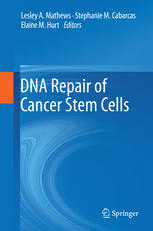
DNA Repair of Cancer Stem Cells PDF
Preview DNA Repair of Cancer Stem Cells
DNA Repair of Cancer Stem Cells Lesley A. Mathews•Stephanie M. Cabarcas Elaine M. Hurt Editors DNA Repair of Cancer Stem Cells 2123 Editors Dr.LesleyA.Mathews Dr.ElaineM.Hurt DivisionofPre-ClinicalInnovation MedImmune NationalCenterforAdvancingTranslationalSciences OncologyResearch NationalInstitutesofHealth Gaithersburg,Maryland Rockville,Maryland USA USA Dr.StephanieM.Cabarcas DepartmentofBiology GannonUniversity Erie,Pennsylvania USA ISBN978-94-007-4589-6 ISBN978-94-007-4590-2(eBook) DOI10.1007/978-94-007-4590-2 SpringerDordrechtHeidelbergLondonNewYork LibraryofCongressControlNumber:2012943246 © SpringerScience+BusinessMediaDordrecht2013 Nopartofthisworkmaybereproduced,storedinaretrievalsystem,ortransmittedinanyformorby anymeans,electronic,mechanical,photocopying,microfilming,recordingorotherwise,withoutwritten permissionfromthePublisher,withtheexceptionofanymaterialsuppliedspecificallyforthepurposeof beingenteredandexecutedonacomputersystem,forexclusiveusebythepurchaserofthework. Printedonacid-freepaper SpringerispartofSpringerScience+BusinessMedia(www.springer.com) Preface Inrecentyears,thestridesmadeinunderstandingandelucidatingboththeoriginsand biological mechanisms responsible for driving cancer progression have been quite impressive. Specifically, themomentumthathascoincidedwiththediscoveryand investigation of cancer stem cells (CSCs), tumor-initiating cells (TICs) or cancer- initiatingcells(CICs)hasbeenenormous.Theinvestigationofeveryaspectofthis deadlyandlethalsubpopulationhasbroughtattentiontoitspotentialinatherapeutic lightwhichwehopecantranslateintotheclinic.Thecancerstemcellhypothesiswas firstdescribedwithdatafrommodelsofhumanleukemiabyJohnE.Dickfromthe UniversityofToronto.Theheterogeneityofhumanleukemiaandthepresenceofstem cellsincancerwasfurthertranslatedintosolidtumorsbyAl-Hajjetal. whenthey publishedaprovocativepaperinProceedingsoftheNationalAcademyofSciences discussingtheabilitytodistinguishtumorigenic(tumor-initiating)cancercellsfrom thenontumorigeniccounterpartbasedontheexpressionofcellsurfacemarkers.The groupreportedthataslittleas100cellsofthisspecificpopulationwereabletoforma solidtumorwheninjectedintothemammaryfatpadofimmunocompromisedmice. Themostcriticalaspectofthisstudywasthedatademonstratingthateventensof thousandsofcellsofthenontumorigeniccancerstemcelldepletedfractionfailedto produceatumor. Since this study, these cells have been heavily investigated and are now known to be the most aggressive cells within a solid tumor discovered to date. In recent years, many groups have demonstrated that in addition to being the most aggres- sive cells, they are highly resistant to current chemotherapy and radiation regimes employedintheclinic. Theresistantnatureofthesecellshasledmanylabsdown thepathofdevelopingnewtherapiestoeradicatethemfrompatients.Aninteresting observationamongourlabandotherswasthatisolatedCSCsexpresshigherlevels ofDNArepairgenes,andfurthermore,leadtoincreasedexpressionofcrucialgenes and pathways that contribute to their drug resistant characteristics. Thus, we have assembledaremarkablegroupofexpertsinbothCSCsandDNArepairtodiscuss their research in light of the role of DNA repair genes and pathways in the CSC population.Thecommonendgoalistocontributetotheknowledgebaseandlead thefieldininvestigatingandstudyingadditionalmechanismsforpotentialtherapies beingdesignedtotargetthisaggressivepopulationofcells. The concept of DNA repair conferring survival and progression is the overall themeofthisbook,andwebelieveprovidesauniquecontributiontotheCSCfield in regards to developing new strategies to target this highly metastatic and resis- tantpopulation.Wehopethisbookcanprovideafoundationandsupporttofuture v vi Preface scientists and clinicians working in the field of cancer resistance and cancer stem cells. LesleyMathews StephanieM.Cabarcas 1. Al-HajjM,WichaMS,Benito-HernandezAetal(2003)Prospectiveidentification oftumorigenicbreastcancercells.ProcNatlAcadSciUSA100(7):3983–3988 2. MathewsLA,CabarcasSM,HurtEMetal(2011)IncreasedexpressionofDNA repairgenesininvasivehumanpancreaticcancercells.Pancreas40(5):730–739 3. MathewsLA,CabarcasSM,FarrarWL(2011)DNArepair:theculpritfortumor- initiatingcellsurvival?CancerMetastasisRev30(2):185–197 Contents 1 IntroductiontoCancerStemCells ............................... 1 ChengzhuoGao,RobertE.HollingsworthandElaineM.Hurt 2 DNARepairPathwaysandMechanisms .......................... 19 ThomasS.Dexheimer 3 ResistanceandDNARepairMechanismsofCancerStemCells: PotentialMolecularTargetsforTherapy.......................... 33 AamirAhmad,YiweiLi,BinBaoandFazlulH.Sarkar 4 DNARepairinNormalStemCells ............................... 53 OlgaMomcˇilovic´ andGeraldSchatten 5 DNARepairMechanismsinGlioblastomaCancerStemCells ....... 89 MonicaVenere,JeremyN.RichandShidengBao 6 DNARepairMechanismsinBreastCancerStemCells ............. 105 HongYinandJonathanGlass 7 DNARepairMechanismsinOtherCancerStemCellModels ....... 125 MihokoKai 8 Pancreatic Cancer Stem Cells inTumor Progression, Metastasis, Epithelial-MesenchymalTransitionandDNARepair............... 141 NagarajS.NagathihalliandErikaT.Brown 9 TargetingCancerStemCellEfficientDNARepairPathways: ScreeningforNewTherapeutics ................................. 157 LesleyA.Mathews,FrancescoCreaandMarcFerrer 10 TheFutureofDNARepairandCancerStemCells................. 173 StephanieM.Cabarcas Index ............................................................ 177 vii Chapter 1 Introduction to Cancer Stem Cells ChengzhuoGao,RobertE.HollingsworthandElaineM.Hurt Abstract Awealthofdatapointstotheexistenceofasubsetoftumor-initiatingcells that have properties similar to stem cells, termed cancer stem cells (CSCs). CSCs arethoughttobeattheapexofacellularhierarchy,wheretheyarecapableofdif- ferentiatingintotheothercellsfoundwithinatumor.Theymayalsoberesponsible for both patient relapse due to their relative resistance to chemotherapy as well as metastasis.Inrecentyears,muchresearchhasfocusedonthesecells,theirproper- ties and potential targets within these cells for cancer treatment. This chapter will introducetheCSCtheory,discussimportantpropertiesofthesecells,andhighlight theneedtotargetthemforimprovedpatientoutcome. 1.1 TheEtiologyofCancer Many hypotheses have been put forth through the years that attempt to explain the etiology of cancer. They have come from divergent fields of study; pathology, molecularbiologyandgeneticsbuttheyallattempttoexplainhowanormaltissue can go from homeostatic equilibrium to something that grows without the checks andbalancesthatgovernnormalbiology.Thesetheoriesinclude,butarenotlimited to, a viral basis of disease, clonal expansion, and the cancer stem cell hypothesis. While each of these theories attempts to explain the etiology of cancer, it is most likelythatsomeoftheseindependenttheoriesworktogethertogiverisetonotonly tumors,buttumorsthatareabletoevadetreatmentstrategies. E.M.Hurt((cid:2)) MedImmune,LLC.,OncologyResearchMedImmune,Gaithersburg,MD20878,USA e-mail:[email protected] C.Gao·R.E.Hollingsworth OncologyResearch,MedImmune,LLC.,Gaithersburg,MD20878,USA L.A.Mathewsetal.(eds.),DNARepairofCancerStemCells, 1 DOI10.1007/978-94-007-4590-2_1,©SpringerScience+BusinessMediaDordrecht2013 2 C.Gaoetal. 1.2 TheCancerStemCellHypothesis Since the early pathologists could look at tissues microscopically the origins and progressionofcancerhasbeenpondered. Itwasnotedthatadvancedtumorsoften presentedwithdiverseareasofdifferentiation,proliferation,invasionandvascularity. ItwasduringthistimeofearlymicroscopicinspectionthatledCohnheim,astudent ofVirchow, to propose his embryonal rest hypothesis ([1] and references therein). Cohnheim had noted that cancer tissues, teratomas in particular, had many of the samepropertiesasembryonictissue.Thisleadhimtospeculatethatcarcinogenesis occurs from dormant remnants of the embryo that are later reactivated. However, thistheorywaslargelyignored.Thespiritofthishypothesisreappeardinthe1970s whenBarryPierceetal.examineddifferentiationinteratomas(reviewedin[1])and determinedthatastemcellwasresponsibleforinitiationoftheteratomas.Theythen furtheredtheseobservationsintoatheorythatallepithelialcancersariseasaresult ofdifferentiation-pausedadulttissuestemcells[2]. Ontheheelsofthishypothesis, camesomeofthefirstevidencethatleukemias mayhaveaCSCorigin.JohnDickandcolleaguesshowedthatasub-populationof acutemyelogenousleukemia(AML)cells, whichsharedaphenotypewithnormal hematopoieticstemcells,couldconfercancerwhentransplantedintoimmunocom- promised mice. Furthermore, the cells that did not have the stem cell-phenotype couldnottransferAMLtorecipientmice[3,4].Severalyearslater,CSCswereiden- tifiedinbreastcancer[5],followedbyamyriadofsolidmalignancies(discussedin moredetailbelowin“1.4IdentificationofCSCs”). 1.3 PropertiesandCellofOriginofCSCs Cancerstemcellsaresonamedbecausetheysharemanyofthesamepropertiesasnor- malstemcells.Theyarecapableoftumorigenesis,self-renewalandcandifferentiate toformtheheterogeneouscelltypespresentintumors(Fig.1.1a).Thesefunctional propertiesledtotheCSCmoniker;however,manyarguethat“tumor-initiatingcells” wouldbeabetterdescriptionofthesecells. Forthepurposesofthisbook, wewill refertothesecellsasCSCs,whereaCSChasbeendefinedas“acellwithinatumor that possess the capacity to self-renew and to cause the heterogeneous lineages of cancercellsthatcomprisethetumor”[6].IthasalsobeenobservedthatCSCsarerel- ativelyresistanttochemotherapyandthereforemayberesponsibleforpatientrelapse following treatment (Fig. 1.1b, discussed in detail in Chap. 3). Thus, the CSC hy- pothesisattemptstoexplainseveralobservationsoftumors,includingthefrequency atwhichtumorcellscangiverisetonewtumors,thegenerationofcellswithmultiple geneticalterations,andtheheterogeneityofcelltypespresentwithintumors. In theory, cancer arises from a single cell that has somehow subverted normal growth restrictions. However, experimental evidence has shown a requirement of manycellsinordertoseedatumor. Forexamplethegrowthoftumorcellsinim- munocompromisedmice,typicallyrequiresthat1–10millioncellsareimplantedin 1 IntroductiontoCancerStemCells 3 Fig. 1.1 Schematic representation of CSC-driven tumor formation. (a) CSCs can either divide symmetrically(self-renewal)togiverisetotwoCSCsortheycandivideasymmetrically(differen- tiation)givingrisetooneCSCandonedifferentiatedprogeny.Theabilitytogiverisetoatumor, toself-renewalanddifferentiateintotheheterogeneouscellpopulationsfoundinthetumorarethe definingcharacteristicofaCSC.ThedifferentiatedprogenyofaCSCareoftenmoreproliferative thantheCSCitself,buttheyhaveafinitereplicativecapacity.(b)CSCsareresistanttoconventional therapies,includingchemotherapyandradiation.Thesetreatmentscaneliminatethemorerapidly dividingdifferentiatedcellsbutleavebehindtheCSC(discussedinmoredetailinChap.3).Once treatmentisstopped,theremainingCSCscanbegintodivideagainandformanewtumorresulting inpatientrelapse ordertoseetumorformation.Thisobservationhasmanypossibleexplanations,in- cludinginjurytocellsuponinjection,therequirementfortherightmicroenvironment (andthedifferenceofthisbetweenhumanandmouse), aswellastherequirement tohaveavarietyofcelltypespresentinordertoefficientlyinducetumorformation. However, even in experiments where human cancer patients were reinjected with theirowntumorcellsatdifferentsiteswithintheirbodies,ittooklargenumbersof cellsinorderforanewtumortoestablish.Again,thiscouldbeconsistentwiththe role of the tumor microenvironment, this time from one site to another; it is also consistentwiththenotionthatonlyasmallproportionofcellsarecapableofgiving rise to a tumor. The idea that only a small proportion of the cells found within a tumorarecapableofgivingrisetoatumorisconsistentwiththeCSChypothesis. ThefrequencyofCSCsinmostcaseshasbeenreportedtobelow(typicallylessthan 5 %) except in the case of melanoma where a variety of cells were shown to have equallyhightumorigenicity[7,8]. The origin of the cancer stem cell is still under debate. The requirement for multiplegeneticinsultsinordertodrivetumorformationhasbeenrecognizedfora longtime[9]. Itissuggestedthatinorderforacelltolivelongenoughtosustain 4 C.Gaoetal. thegeneticinsultsrequiredtodrivetumorformation,itislikelythatanormaladult stem cell is the originator of a CSC phenotype. Mathematical models support this theory[10].Furthermore,theleukemicstemcells(LSCs)ofCMLpatientsexpress BCR-ABL,thecommontranslocationthatdrivescellulartransformation[11].This provides experimental evidence that CSCs sustain the genetic insults that are seen todrivecarcinogenesis.TheidentificationinCSCsofoncogenicdrivermutationsis alsobeginningtoemergeforsolidtumors. Forexample, theTMPRSS:ERGfusion hasbeenfoundinprostateCSCs[12]. However,itisstillpossiblethatamoredifferentiatedcellundergoesthesegenomic rearrangements and additionally picks up further mutations that impart the ability to self-renew as well as differentiate. Indeed fibroblasts can acquire the properties ofpluripotentstemcellswiththeactivationofjustafewgenes[13–15].Moreover, itwasrecentlyshownthatacatastrophiceventinthecellcanleadtomanygenetic alterationsatasingletime[16].Itmayalsobethatenvironmentalcuescantrigger CSCpropertiesevenindependentofDNArearrangements.Forexample,ithasbeen noted that cells undergoing epithelial-to-mesenchymal transition (EMT), a normal developmental process that promotes cancer invasion and metastasis, can acquire characteristics of CSCs [17]. These ilines of evidence suggest that a cell does not need to be long-lived in order to sustain many genetic alterations and that CSC propertiescanbebestowedbybiologicalprocesses,andwouldthereforearguethat anycellmaybethefodderforCSCs. 1.4 IsolationofCSCs Currently, there are several commonly used approaches for the isolation of cancer stemcells,including:(1)sortingofasidepopulation(SP)byflowcytometrybased onHoechstdyeefflux,(2)sortingofCSCsbyflowcytometrybasedoncellsurface marker expression, (3) enriching of CSCs by non-adherent sphere culture and (4) sortingofCSCsbyflowcytometrybasedonaldehydedehydrogenase(ALDH)ac- tivity (Fig. 1.2). All of these approaches enrich for CSCs to varying degrees, and eachofthemhasitsownadvantagesandlimitations,whichwillbediscussedbelow. 1.4.1 SidePopulations Goodell and colleagues, while analyzing murine bone marrow cells, discovered a smallanddistinctsubsetofwholebonemarrowcellsthatwereunstainedbyHoechst 33342, a vital dye [18]. This Hoechst 33342 low population is termed SP. They foundthattheSPhadthephenotypicmarkersofmultipotentialhematopoieticstem cells and were able to repopulate the bone marrow. Following their work, the SP has been extended to a variety of cancer types, including leukemia [19, 20], ovar- ian cancer [21], hepatocellular carcinoma [22], brain tumors [23–25], lung cancer [26,27],thyroidcancer[28],nasopharyngealcarcinoma[29],mesenchymaltumors
